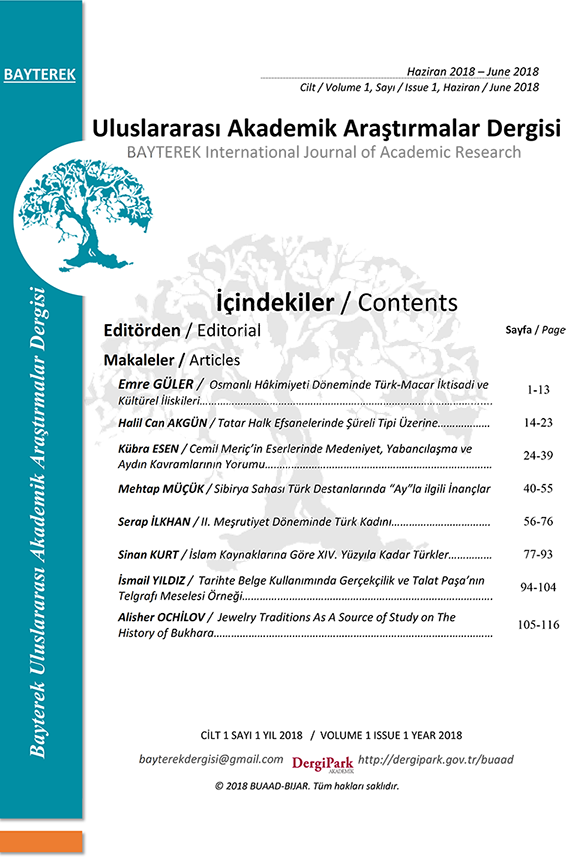DAĞISTAN’IN TÜRK KÖKENLİ HALKLARI
Orta Asya’daki otoritesini kaybeden Hunlar, batı yönünde hareket etmiş Karadeniz’in kuzeyine ulaşmıştır. Söz konusu bu Hunların Kafkasya’ya inen kısmı bu coğrafyada etkin roller oynamıştır. Hunların haricinde Kök Türkler, Hazarlar, Kıpçaklar da Kafkasya’da varlık gösteren Türk devletlerinden olmuşlardır. Bu devletler siyasi varlığını kaybedip tarih sahnesinden çekilmiş olsa da kökenleri onlara dayanan Kumuklar, Nogaylar, Terekemeler gibi topluluklar söz konusu coğrafyada varlıklarını sürdürmeye devam etmektedirler. Dağıstan coğrafyasında Türk kökenli bu toplulukların haricinde Avarlar, Darginler, Lezginler gibi milletler de vardır. Onlar kendi kaderlerini belirleyecek siyasi bir yönetim oluşturamamışlar, Rusya’ya bağlı özerk bir cumhuriyet olarak yönetilmektedirler. Dağıstan’daki Türk gruplarının dilleri günümüz Türkiye Türkçesinden çok farklı olmasa da onlar büyük oranda Türklük bilincini yitirmişlerdir. Bunun yanı sıra “Sulak, Kayakent, Kızılyurt” gibi birçok Türkçe yer adının varlığı da coğrafyadaki Türk varlığıyla ilişkilidir. Bu çalışma Dağıstan Türklerinin kimlikleri ve bugünkü durumları hakkında bilgi sunmaya adanmıştır.
Peoples of Turkic Origin of Dagestan
Dagestan is an autonomous republic in Russia. The capital of the country is Mahachkala, while other important cities are Derbent, Buynak, Hasavyurt, Kizilyar and Izerbash. The Autonomous Republic of Dagestan, which has an area of 50,300 km2, is surrounded by the Autonomous Republic of Kalmuk to the north, the Caspian Sea to the East, Azerbaijan to the South, Georgia to the southwest, Chechnya to the west and Northwest and the North Caucasus. It is located at a very important point in the geopolitical sense of Dagestan, which connects Russia in a geographical sense to the Eastern countries. With mountain ranges, high plateaus and many deep valleys, this country deserves the name “Dagestan”. The mountainous nature of the geography caused the population to live scattered, which made various nations closed to each other's influence in many ways. In this way, more than thirty communities in a small geography such as Dagestan have learned to live in their own state without harming each other. The arrival of tribes in Dagestan, which could not find what they hoped for in international relations, led to an increase in ethnic diversity in the region, which also led to Dagestan being called a country of languages. If you look at geography from the point of view of Turkish history, it is possible to judge that the Turkish presence provides continuity. The Turks, who migrated from Central Asia to the north of the Black Sea for various reasons, left a very deep influence on the fate of the Caucasus and, even more specifically, Dagestan. First, the Huns lost their authority in the homeland and moved in a western direction and reached the north of the Black Sea. Some of these Huns in question landed in the Caucasus and played active roles here. Besides the Huns, the Kok Turks, Khazars and Kipchaks were also among the Turkic groups that existed in the Caucasus. Kumuks, Nogays and Terkemes, whose origins date back to these Turkic groups, continue to exist in Dagestan. Today, the vast majority of Dagestan people have a sympathy for Turkey and the Turks. The languages of Turkic groups in Dagestan are not very different from modern Turkish. In Dagestan, it is possible to express themselves largely in Turkish without the need for any other language: but as a result of living dependent on Russia for a long time, the number of people using their mother tongue is gradually decreasing among the young population. In addition, the presence of many Turkish place names such as” Sulak, Kayakent, Kizilyurt " is also the most effective way to see how deep-rooted the Turkish presence in the region is.
___
- Gaciev, V.G. (1993). İstoriya Dagestana. Mahaçkala: Daguçpedgiz.
- Gimbatova, M.B. Turkoyazıçnıe Narodı Dagestana: Teritoriya Rasselehiya, http://slavakubani.ru/culture/etnography/tyurkoyazychnye-narody-dagestana-territoriya-rasseleniya/ (17.11.2020)
- Kafesoğlu, İ. (1997). Türk Millî Kültürü. İstanbul. Ötüken Yay.
- Karatay.O. (2018). Hazarlar. Ankara: Kripto Yay.
- Kurat, A.İ. (2019). IV- XVIII. Yüzyıllarda Karadeniz Kuzeyindeki Türk Kavimleri ve Devletleri, Ankara: TTK Yay.
- Laypanov.K. T. vd. (2014). Türk Halklarının Kökeni, İstanbul: Selenge Yay.
- Magamedov, S. H. (1979). Derbent-Gornaya Stena. Moskva: İzdatelstvo İskustvo.
- Moses, Kalankatlı (2006). Alban Tarihi. Azerbaycan Türkçesine Çev. Ziya Bünyadov, Türkiye Türkçesine Çev. Yusuf Gedikli. İstanbul: Selenge Yay.
- Novoseltsev, A. (2017). Hazarskiy Kaganat, Moskva: izdatelstvo Lomonosov.
- Şukin, M. B. (2005). Gotskiy Put. Sankt Petersburg: İstoriçeskie İsledovaniya.
- Yakubovskiy, A. Y. (1976). Altın Ordu ve Çöküşü. Ankara: Kültür Bakanlığı Yay.
- Yücel, M. U. (2007). İlk Rus Yıllıklarına Göre Türkler. Ankara: TTK Yay.
- Yayın Aralığı: Yılda 2 Sayı
- Başlangıç: 2018
- Yayıncı: Onur Alp KAYABAŞI
Sayıdaki Diğer Makaleler
YABANCI DİL OLARAK TÜRKÇE KELİME ÖĞRETİMİ ÜZERİNE BİR DEĞERLENDİRME
DAĞISTAN’IN TÜRK KÖKENLİ HALKLARI
OBO KÜLTÜ ve MUĞLA MEKE KÖYÜ OBOLARI
BASINDA RAUF RAİF DENKTAŞ VE KIBRIS MÜCADELESİ
YUMUŞAK GÜÇ KAYNAĞI BAĞLAMINDA YABANCI DİL OLARAK TÜRKÇENİN ÖĞRETİMİ
SEYFÜ’L-MÜLÜK İLE BEDİÜ’L-CEMÂL HİKÂYESİ’NİN MOTİFLERİ ÜZERİNE
